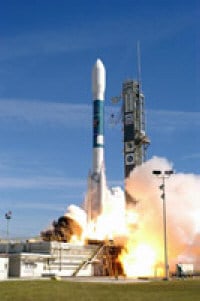The first space mission dedicated to gamma-ray bursts was launched from the Kennedy Space Center in Florida on Saturday. Gamma-ray bursts are the most energetic events in the universe, but they continue to baffle astrophysicists more than 30 years after they were first discovered. The Swift mission, which will run for at least two years, is expected to observe at least 100 events per year.

Gamma-ray bursts are violent explosions that give off intense flashes of gamma rays that can last for times that range from a few milliseconds to about a hundred seconds. The initial burst of gamma rays is then followed by an afterglow of longer wavelength radiation that can last for weeks or even years. It is thought that an average of about one gamma-ray burst takes place every day in the universe, and many believe that they happen when a massive star undergoes a supernova explosion at the end of its life and collapses to form a black hole.
The Swift observatory has three instruments. The Burst Alert Telescope (BAT) will continually observe the sky for flashes of gamma rays. Within 20-75 seconds of spotting an event the spacecraft will be able to “swiftly” reposition itself so that its other two telescopes point towards the burst to observe its afterglow at optical/ultraviolet and X-ray wavelengths. The X-ray telescope will also be used to perform the most sensitive survey to date of the sky at wavelengths below about 10 Angstroms and possibly discover as many as 400 new supermassive black holes.
There are thought to be two main types of burst: long bursts lasting for over two seconds, and shorter bursts with durations of just a few milliseconds. Swift will be fast enough to identify afterglows from short bursts for the first time. Moreover, it will be able to detect fainter – and therefore more distant – bursts than previous satellites. Information from these distant bursts will help astronomers to understand how the first generation of stars formed in the universe.
Previous missions have carried out gamma-ray astronomy but Swift has been designed to respond to gamma-ray bursts faster than any of these. The mission, which has a total cost of $250m, is a joint effort by NASA, the Italian Space Agency and the Particle Physics and Astronomy Research Council in the UK.



